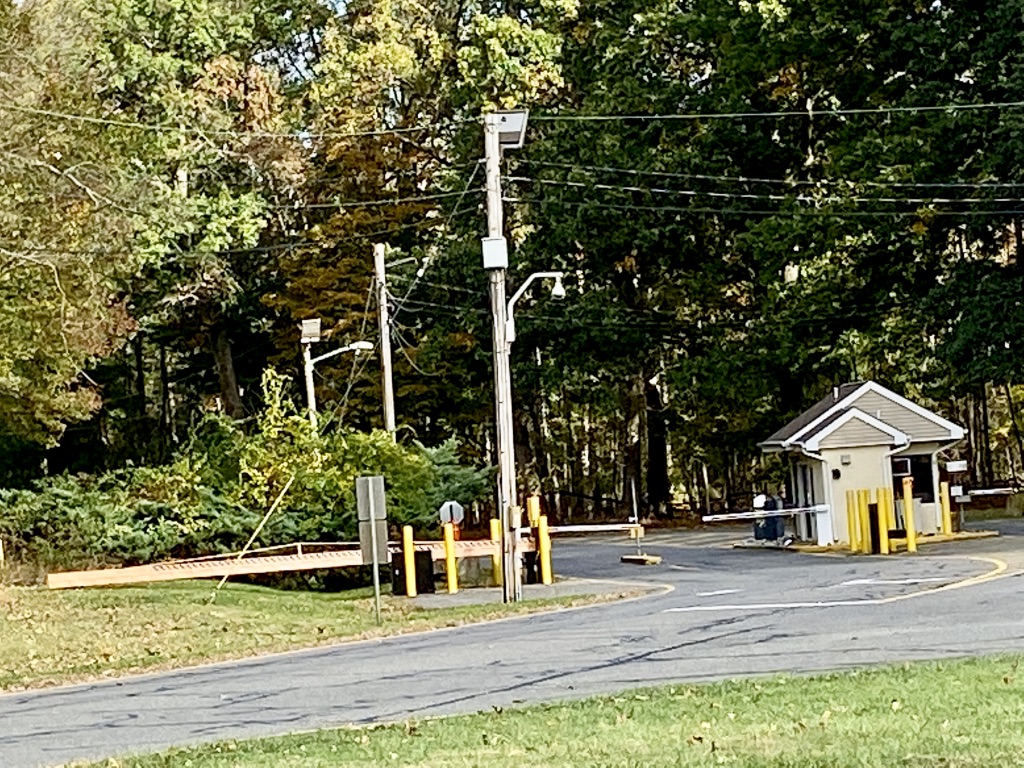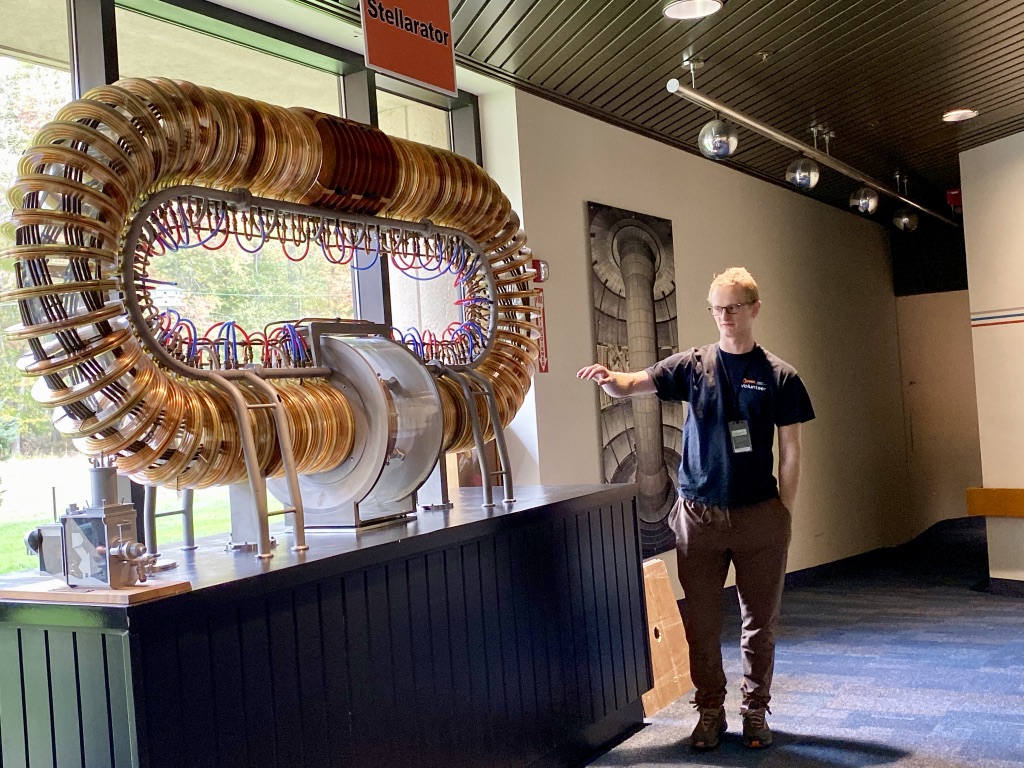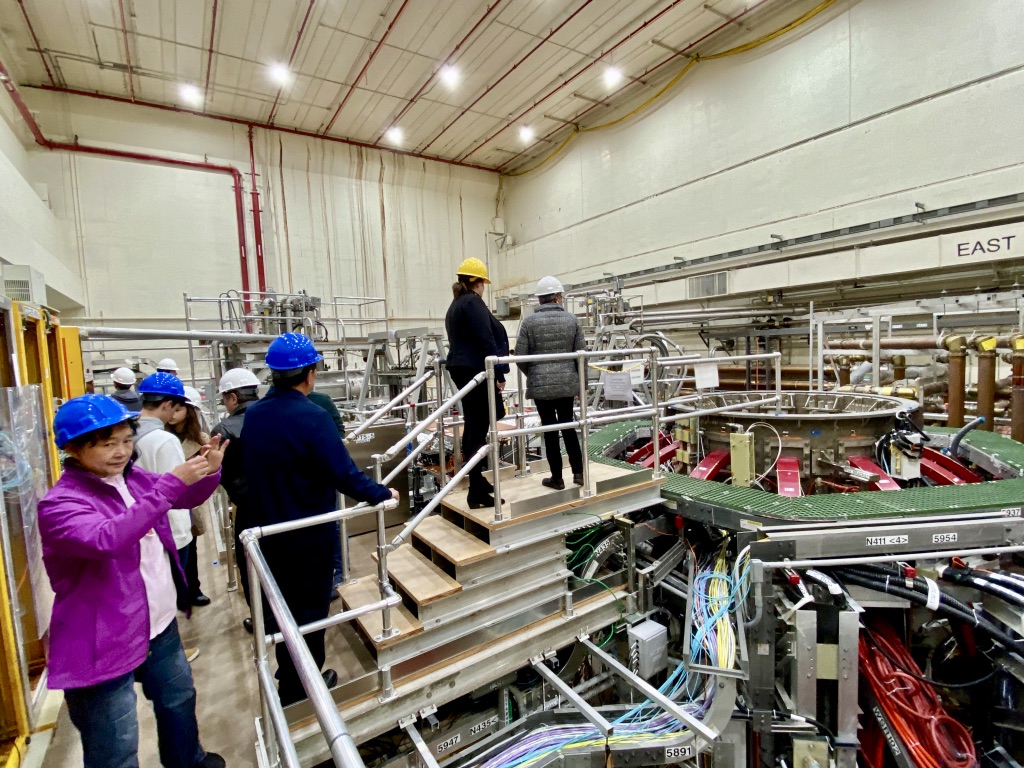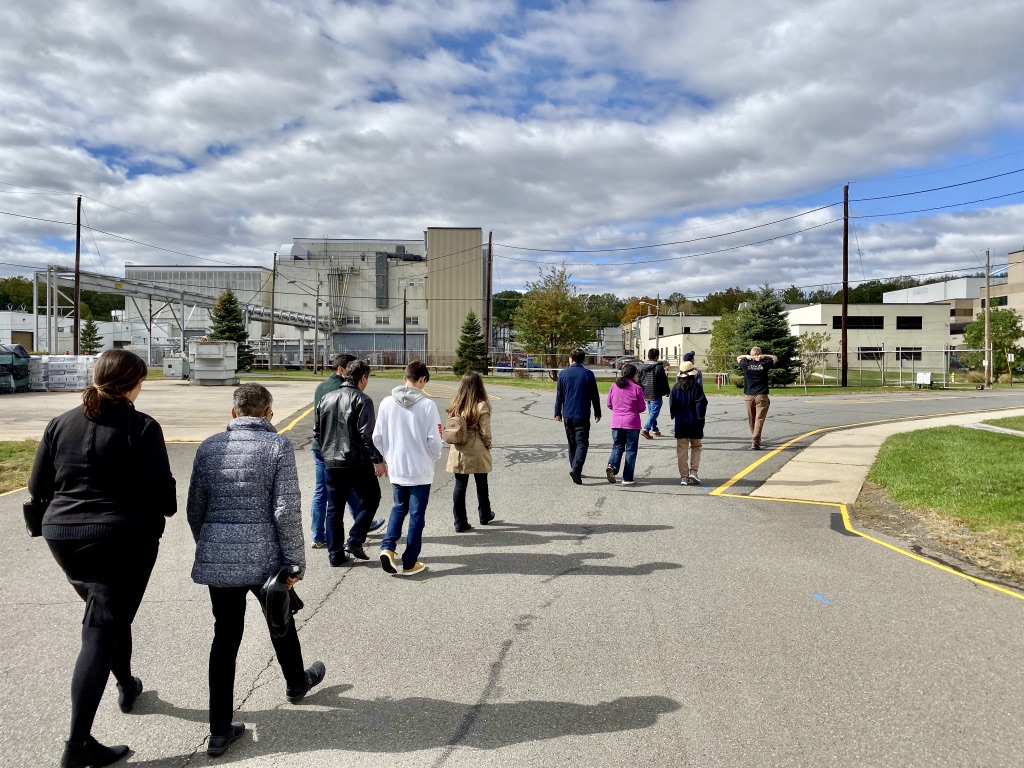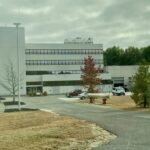A poetic phrase on the U.S. Department of Energy’s website drew my attention to the Princeton Plasma Physics Lab (PPPL) in New Jersey. The phrase describes fusion energy sciences as “…bringing the energy-producing power of a star to Earth for the benefit of humankind.” Like most people, I’m not familiar with how fusion energy works and why it’s so difficult to obtain. But we’re all wondering if it can or will help save our planet from calamitous effects of climate change.
The PPPL plays a prominent role in plasma physics and fusion energy research. In 2019, through their website I registered to attend a public tour and encouraged my cousin Charlie to do so too. He agreed. He lives in Philadelphia, just 45 miles from Princeton. Now retired, Charlie formerly analyzed plastics for bio-chemical markets. He now likes working with wood. When I reach his house, he was pulling on a cable to charge his white Tesla sedan. Our journey to the lab would not emit any carbon into the beautiful blue sky overhead.
During the drive I tell him about the lab’s history. In 1951 during the Cold War a professor from Princeton received funding from the U.S. government to study and develop fusion power for weapons under a top-secret project called Matterhorn. A decade later the focus changed to basic research so the lab name changed too.
“I never would have thought of visiting a national lab,” Charlie says. Yet he is familiar with lab life. His father, my uncle Bob, was a chemical engineer at Oak Ridge National Lab in Tennessee. He worked on nuclear fission during another top-secret undertaking, the Manhattan Project. As we grow closer to Princeton Charlie admits to not knowing much about his father’s work. “He rarely talked about it. I guess I didn’t ask either.”
In Princeton we follow Scudder Mills Road to Campus Drive and curve around some tall trees before reaching the lab’s entry guard house. We show our registration papers and pass through. A security background check is made on all visitors prior to their attending the public tour.
The goal of fusion research is to create sustainable energy much like the stars do. That means energy without greenhouse gases or long-term radioactive waste. The risk of accidents occurring with fusion is diminished because unlike fission which creates an uncontrolled chain reaction, a fusion reaction is controlled through a precise calculation of temperature, pressure and magnetic field. A disruption in any of these causes the reaction to end without incident.
Fusion’s promise as a clean, renewable source of energy has yet to fully pan out after 80 years of research. But that fact doesn’t dampen the enthusiasm of our guide, graduate student Oak Nelson.
“Oak? As in the tree?” Charlie asks after the young man introduces himself to our tour group. Bashfully, the tall lanky blonde-haired guide responds, “Yah. I grew up in Colorado.” He’s on break from classes and has time to be a guide before his next research project begins.
Plasma cloud
The lab’s lobby contains a lounge area where science-related posters hang on the walls. Against a windowed wall a hands-on plasma machine beckons visitors. I immediately gravitate towards the machine before the tour starts. I wait as two middle-aged women fiddle with its handle. By sliding and rotating the handle one can manipulate a magnetic field that pushes and swirls the plasma. The plasma appears as a pink, cloudlike smoke. The ladies allow me. I move the handle slowly at first and then quickly. The plasma cloud responds to my touch, billowing and thickening. I have no idea what it’s used for, but I feel powerful controlling it. The ladies tell me they live nearby and have long been curious about what happens inside this lab. “We are looking for something hopeful with all that’s going on in our country,” the tall one says. They nod to each other. I think they are referring to the political division in our country, but I say nothing in response.
Oak asks our group if anyone knows about plasma. No one raises a hand or speaks up. He explains it as a fourth state of matter where fusion reactions take place. “Ninety nine percent of the universe contains plasma,” he says. None of us knows about this? “Basically, plasma is very hot, charged gas,” he continues. Some of what plasma research has led to are computer chips and flat screen televisions.
We stop to eye what looks to me to be a modern work of sculpture. But it is actually a plasma containment device called a stellarator that was used in early nuclear fusion experiments. Relics such as this are to remind us of how far we’ve come.
To explain fusion, Oak shows us a video with two animated nuclei portrayed as Pacman-like figures. They fuse together and ‘Pow!’ form heavier elements that release a lot of energy.
Fusion’s two sources of fuel are hydrogen and lithium, both plentiful on Earth. Oak is excited about something called ITER, pronounced “eater”. It’s a plasma physics experiment being conducted at CERN, the European organization for nuclear research in France. December of 2025 is the planned date for ITER to launch and create plasma that will reach temperatures of 150 million degrees Celsius. That’s about 10 times hotter than the center of our sun. Wow!
NSTX-U, apple versus doughnut
We move on to the National Spherical Torus Experiment Upgrade (NSTX-U). It’s the most powerful experimental fusion facility of its type in the world. Its design distinguishes it from others by using a cored apple shape rather than a larger doughnut shape. The hope is that the spherically shaped plasmas created could allow them to develop smaller, more economical and more stable fusion reactors. The big question here is can a machine be built where the energy produced surpasses the energy used to trigger and sustain the reaction. They are searching for the right recipe of heat and plasma density.
“We can change the planet with fusion,” Oak says as if the solution is at his fingertips. The challenge is on. Our sun’s core fuses 600 million metric tons of hydrogen per second.
The NSTX-U main control room looks similar to a lecture hall with banks of computers. It’s here where the power of high-speed computing, machine learning, simulators and models are pushing the perimeters that may lead to success. From there, we pass through an underground tunnel to enter a maze of thick copper-colored pipes that stand as walls and a ceiling at the base of NSTX-U.
Charlie and I climb a stair with the rest of the group. I ask a graduate student from Carnegie Mellon University why he came on the tour: “I’m studying computer science so am curious about how data is gathered and the simulations they use.” A young Asian woman tells me she wanted to take the tour because her husband works here. At the top of the stair a young physician from Georgetown takes selfies with his father, who works as a mechanical engineer at the lab. His mom is a doctor. “My son takes after his mother,” the father jokes.
At different times we take turns stepping up to what I call the lookout platform. Instead of marveling at a deep canyon or distant forest, we peek at the top of the most powerful spherical tokamak (nuclear fusion reactor) in the world. There is no natural light, no windows or wind. No sound is emitted. A tennis-court-green grid surrounds the circular mouth of the tokamak. Inside is a stew of electrons and atomic nuclei. Red painted superconducting magnets and multi-colored cables bulge from its belly. A bank of electronic equipment records its every move. I don’t see any of the star part here – the shining light, the friendly twinkle or the streaking trail across a night canvas.
Family members from Brazil approach the lookout platform snapping pictures. They are visiting a relative who works as a theoretical physicist here. The daughter in the family, Letica, says: “This is our future. My generation wants to know how we can live in a clean environment. It’s great to be a part of it.” The two middle-aged women I met in the lobby agree with her. “It’s terrific. Fascinating to see the work they are doing here.”
Before we leave the NSTX-U the Carnegie Mellon student asks: “How do you debug any problems?”
“Good question,” says Oak. “We had to call a retiree recently to diagnose a problem with the circuits. We’re glad he was available. This system has been growing organically for the last 20 years.”
Cousin Charlie smiles at the thought of a retiree coming in to fix it. “I guess it’s best to keep us around,” he says.
Public outreach
I had arranged in advance to meet with physicist Andrew Zwicker who heads the Office of Communications and Public Outreach at the lab. I asked him why they are optimistic now after decades of chasing the gold ring of fusion energy. He gives me a trio of reasons for why today’s optimism is not misplaced. “Our computing speed has increased tremendously. We use sophisticated simulators that allow us to tweak design easier. And advanced manufacturing capabilities allow us to create the components as needed.”
Zwicker tells me that their most popular public outreach program is the Ronald E. Hatcher Science on Saturday lectures. The lectures are held in the MGB Auditorium and have been ongoing for 34 years with an average of 300 people attending. They are live streamed at 9:30am EST for nine weeks from January to March. Any member of the public can watch live on the PPPL.gov website.
Cousin Charlie sums up his thoughts on the tour as we walk to the parking lot: “I like the matter-of-fact personality of scientists. They want to find answers, not impose them like politicians do. That’s refreshing. It’s a precise, efficient operation here. The computers, modeling and prediction theory weren’t around when I was in school.”
I think of my master-of-the universe moment in the lobby when turning the handle to control the plasma machine. I ponder fusion science. Are we called to understand, emulate, one up the sun?
Charlie and I look for but don’t see any other electric cars in the lot. We spend the rest of the day in Princeton eating lunch at a farm-to-table restaurant, visiting the University Chapel and the Art Museum on Princeton’s main campus. During our drive back under the night sky I look up. My understanding of star power has forever changed. The crook in my neck assures me that my star wonder remains intact.
The search to harness fusion energy continues. In December of 2022 the U.S. Department of Energy announced an achievement of fusion ignition at Lawrence Livermore National lab. Scientists conducted the first controlled fusion experiment in history to produce more energy from fusion than the laser energy used to drive it. We will see where it goes from there.

